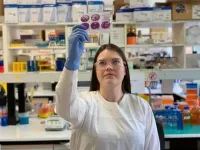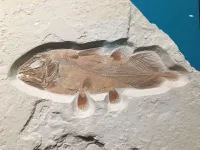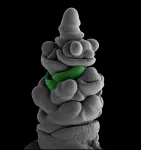(Press-News.org) Since the 1980s, the physical and mental health of Swedish children and young people has been measured by way of surveys. One of these is the international "Health Behavior in School-aged Children Survey" (HBSC), which is taken by 11-, 13- and 15-year-olds every fourth year during a class in school.
Researchers Anette Wickström and Kristin Zeiler at Linköping University wanted to study the survey to see which norms can be conveyed in health surveys, something that has rarely been studied. The results have been published in the journal Children & Society.
"The study shows that survey questions on parents' occupation and financial situation create norms about how you should be and what you should own. Our interviews also show that some teenagers ask themselves if they should respond according to reality or in a way that protects themselves and the people they care about", says Anette Wickström, associate professor at the Department of Thematic Studies at Linköping University, who has previously studied norms and ideals in relation to health.
Survey raised thoughts they had not previously had
These surveys can be seen as a tool for finding out about the wellbeing of young people. But they can also be given a broader significance, as carriers of meaning and norms. This theoretical approach, from science and technology studies, is the one taken by the researchers.
By way of 51 interviews with 15-year-olds in three school classes, an understanding of how the teens view the surveys emerged.
According to the results of the study, some of them feel that the survey conveys a message about how people should live. The very existence of questions about having one's own room, and about the number of computers and bathrooms in the home, was perceived by some of them as a message that they should have these things. Similarly, they remarked that the survey questions about weight and body can give rise to negative thoughts that they previously had not had.
The survey also made them aware of differences, especially with regard to their families' financial situation. While some of them said the survey made them realise how fortunate they are, others said they felt afraid of appearing poor.
A growing field of research shows that a person's subjective idea of their socioeconomic status can affect their health more than their objective status does. In other words, it is more important for your health how you perceive your income and your status in society than how much you are actually paid.
"The young people say that the survey raises issues of status. If we know that the subjective understanding of your social status can mean more for your health than the actual situation, we can ask how this type of question impacts the teenagers", says Anette Wickström.
Motivating or guilt-inducing questions
The young people's experience of completing the survey differed. Some felt the survey was fun and informative, a "guide" to how you should live, which motivated them to set new targets.
Others said the survey was difficult to complete because it induced feelings of guilt, responsibility and inferiority. Some of them wondered about who is responsible for them feeling good. They felt the survey assumed that they themselves were ultimately responsible for - and could influence - their health. However their view was that largely, their health was reliant on external factors, things outside their control, such as deaths, abuse and conflict in the family.
Providing sensitive details in a classroom
The interviews also showed that it was difficult for the teenagers to complete the survey in privacy. Some reported that they tried to hide their questionnaire for fear of their classmates seeing it, while others said that questions and answers were discussed openly in the classroom.
Other interviewees spoke of the risk of being reminded of memories they didn't want to revisit while sitting amongst their classmates. Regarding the question of how old they were when they first had sexual intercourse, one girl commented: "If you've been abused and have never had sex voluntarily, how should you respond?"
Anette Wickström explains that the results of the study are a reminder that surveys and questionnaires require constant reflection.
"Rather than thinking that some surveys should be stopped, we feel that we should apply our new-found knowledge when creating new surveys. You have to think about how they are designed, distributed, how questions and pre-defined responses are worded, and if schools can offer psychological support after the survey. And of course you should also reflect about whether questions about such sensitive topics should be included."
INFORMATION:
A subtype of asthma in adults may cause higher susceptibility to influenza and could result in dangerous flu mutations.
University of Queensland-led animal studies have found that paucigranulocytic asthma (PGA) - a non-allergic form of the condition - allows the flu virus to flourish in greater numbers in sufferers.
UQ PhD candidate Ms Katina Hulme said this was due to the asthma's suppression of the immune system.
"We were first tipped off about this during the 2009 swine flu pandemic," Ms Hulme said.
"Asthma was identified as the most common underlying medical condition in ...
These observations might be useful for the future development of new antibacterial strategies. The team reports in the journal Applied and Environmental Microbiology on 12 February 2021.
Bacterial groups in search of food
We commonly know predator-prey relationships from the animal kingdom, but they are also a survival strategy of certain bacteria: bacterial predators actively kill bacteria of other species in order to feed on them. The predatory species include many myxobacteria, which are widespread in the soil and display unique behavioural patterns: many cells assemble into large groups and go in search of food together or, in the event of nutrient ...
Scientists from the University of Gothenburg, Sweden presents evidence that hospital wastewater, containing elevated levels of antibiotics, rapidly kills antibiotic-sensitive bacteria, while multi-resistant bacteria continue to grow. Hospital sewers may therefore provide conditions that promote the evolution of new forms of antibiotic resistance.
It is hardly news that hospital wastewater contains antibiotics from patients. It has been assumed that hospital sewers could be a place where multi-resistant bacteria develop and thrive due to continuous low-level antibiotic exposure. However, direct evidence for selection of resistant bacteria from this type of wastewater has been lacking, until now.
A research group at ...
A polymer that is custom designed to produce light that penetrates murky environments has shown promise in bioimaging trials, where it can detect nano-sized particles underneath the surface of realistic tissue models.
Recent studies have demonstrated that fluorescent probes -- light-emitting materials that attach to tiny targets such as cells -- are particularly useful for bioimaging when they radiate in the shortwave infrared (SWIR) region of the optical spectrum. Because this type of fluorescent light penetrates deeper into biological objects without being absorbed or scattered, SWIR ...
Humans inhabit an incredible range of environments across the globe, from arid deserts to frozen tundra, tropical rainforests, and some of the highest peaks on Earth. Indigenous populations that have lived in these extreme environments for thousands of years have adapted to confront the unique challenges that they present. Approximately 2% of people worldwide live permanently at high altitudes of over 2,500 meters (1.5 miles), where oxygen is sparse, UV radiation is high, and temperatures are low. Native Andeans, Tibetans, Mongolians, and Ethiopians exhibit adaptations that improve their ability to survive such conditions. Andeans, for example, display increased chest circumference, elevated oxygen saturation, and a low hypoxic ventilatory response, enabling them to thrive at exceptionally ...
New study from Warwick Medical School examined the effectiveness of three alternatives to CPR, concluding that none were beneficial
First comprehensive systematic review of evidence on precordial thump, percussion pacing and cough CPR - all of which have fallen out of routine practice
Precordial thump is often portrayed in television and film, and cough CPR misinformation circulates frequently on social media - but neither are effective
Reaffirms CPR as the 'gold standard' technique when assisting someone experiencing a cardiac arrest
A technique frequently portrayed in dramatic resuscitation scenes in television ...
Scientists created a framework to test the predictions of biological optimality theories, including evolution.
Evolution adapts and optimizes organisms to their ecological niche. This could be used to predict how an organism evolves, but how can such predictions be rigorously tested? The Biophysics and Computational Neuroscience group led by professor Gašper Tkačik at the Institute of Science and Technology (IST) Austria has now created a mathematical framework to do exactly that.
Evolutionary adaptation often finds clever solutions to challenges posed by different environments, from how to survive in the dark depths of the oceans to creating intricate organs such as an eye or an ear. But can we mathematically predict these outcomes?
This is ...
Fossilised remains of a fish that grew as big as a great white shark and the largest of its type ever found have been discovered by accident.
The new discovery by scientists from the University of Portsmouth is a species of the so-called 'living fossil' coelacanths which still swim in the seas, surviving the extinction that killed off the dinosaurs.
The discovery was purely serendipitous. Professor David Martill, a palaeontologist from the University's School of the Environment, Geography and Geosciences, had been asked to identify a large ...
In plants, the "meristem" refers to a type of tissue comprising undifferentiated cells from which various other plant organs can develop through cell division and differentiation. These "plant stem cells" give rise to shoots, leaves and roots, but also spikes and flowers.
The research team including members of the Cluster of Excellence on Plant Sciences CEPLAS investigated the function of a gene responsible for the different spike forms of wheat and barley. This gene controls the activity of the spike and floret meristems and thus the number of spikelet ...
The research team that developed a biosensor that first recorded that a distinct gradient of the plant growth hormone gibberellin correlated with plant cell size has now revealed how this distribution pattern is created in roots.
Starting when a plant embryo forms within a seed and continuing throughout the plant lifecycle, undifferentiated stem cells undergo radical transformations into specialised root, stem, leaf and reproductive organ cells. This transformation relies on a suite of molecules called phytohormones that, much like human hormones, can move between cells and tissues and trigger distinct biological processes across the bodyplan. While it was not known at the time, mutations involving the gibberellin class of ...





